In the classic story 1,001 Arabian Nights, King Shahryar murders each of his new brides because he is afraid they will stop loving him. The nightly assassinations cease when he marries Shahrazad, whose tales of heroes and villains are so engrossing that he postpones killing her so he can hear the end of her tale.
Inspired by this story, five Taiwanese jewelry designers have set up shop in the basement of the Dunhua Eslite bookstore and will create 1,001 distinct rings before the end of the month.
A workstation surrounded by a circular display case is located near the entrance of the gallery where a team of designers from various fields of architecture, interior design or fashion produces 20 to 40 rings each day.
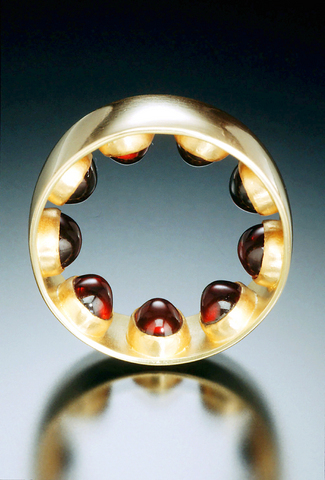
PHOTOS COURTESY OF THE DESIGNERS
Their purpose is to expand the possibilities in ring design said one of the participating designers, Nick Dong (董承濂).
Not to be confused with a conceptual art exhibition, WondeRING (異想世戒) is a commercial display presenting the talent of emerging jewelers and showcasing a range of accessories that are functional, meaningful and remarkably stylish.
The immense bookstore houses many local jewelers, both those behind glass cabinets inside the building and portable vendors lining the street entrance. What sets the five gallery artists apart from the competition are their unconventional designs, not all of which are marketable. The exhibition is like a sample sale for consumers who are looking for originality and innovation in their accessories.
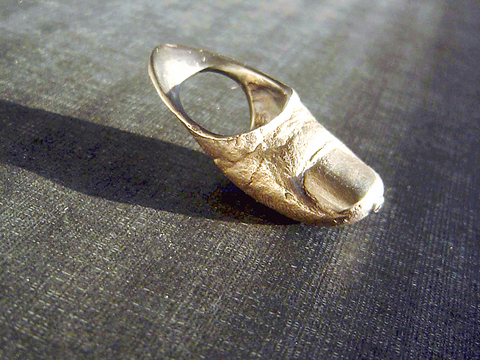
"Metal work is a popular discipline now, mostly because people are interested in making jewelry," Dong said. "We are all designers with a background in metal work so it's easy for us to make a plain silver ring, but our purpose here is to create and illustrate something different and original," he added.
Most of the one-of-a-kind pieces can be purchased on the spot or used as a reference for custom-made jewelry. It's an extremely tactile exhibit where anything can be tried on and likewise it gives shop owners a few tips on merchandising techniques.
The display area is divided into four sections -- gemstones, costume, functional and commitment ring designs with chairs at each table enabling visitors to sit down and try on different pieces.
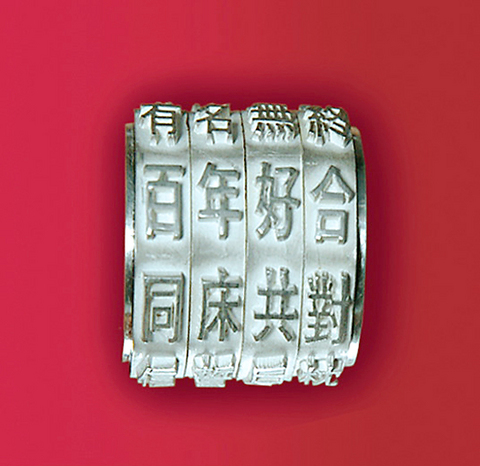
The men's and women's gemstone rings are a trademark item of Dong's, who first casts a gold or silver band, then inserts each stone by hand on the inside leaving a smooth polished band of silver or gold on the outside. Placing the stones on a band produces an effect that is less flashy and makes them ideal for men because they are chic, yet simple and masculine.
The aptly named "wearable sculptures" collection has a large range of cocktail-size rings by Zhun Jing-wun (鄭景勻) and Lien Xi-wei (連時維) that look more like fashion statements than marketable items. There is little danger that rings molded with human hair woven into the setting or made from latex, bone and even teeth will become the latest accessory trend, but they might still appeal to collectors.
Yang Hsi-hsai's (楊夕霞) cage-like finger rings have an abstract allure and given their size are remarkably lightweight and comfortable to wear.
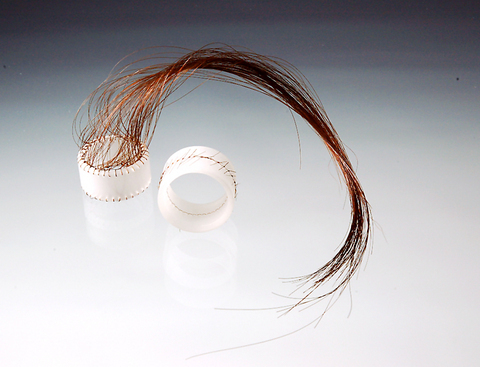
The functional selection highlights rings designed to be useful and stylish. Lin Li-chen (林俐貞) produces a variety of different size and color egg-shaped rings made from durable ceramic that won't crack or break easily. The ring's rounded shape resembles a hollowed eggshell allowing the wearer to use it as a massage tool.
One of Dong's designs includes a version of the earpiece used by mobile phone users. Instead of attaching a device to an ear, it is worn on two fingers and has a small stone inset, which lights up when there is an incoming call.
The ring would be difficult to market due to its high production costs, but the concept impressed a representative from a major electronics company at the opening of the exhibit who now wants to meet with the designer.
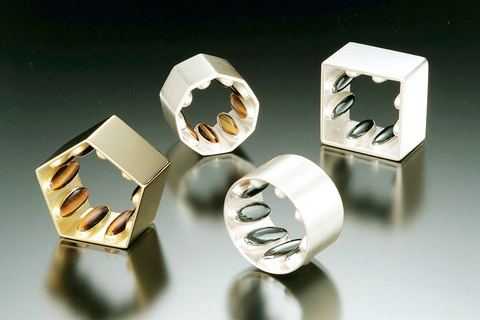
Equally practical is the series of commitment rings intended to show alternatives to the traditional engagement rings and wedding bands.
Prices for the inventive works range from NT$2,500 for a chunky sterling silver or ceramic ring to NT$35,000 for the Bluetooth device. A complete price list is available in the Eslite bookstore gallery located at 243, Dunhua S Rd, Sec 1, Taipei (誠品畫廊 / 台北市敦化南路一段243). Whether for shopping or browsing, the exhibition is in Taipei until the end of the month, when it will move to Taichung, then to Kaohsiung and Tainan. To contact individual designers about their work send an e-mail to wonder_ring@yahoo.com.
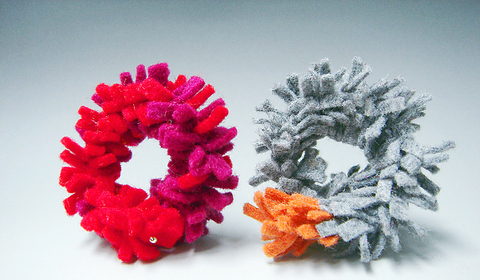
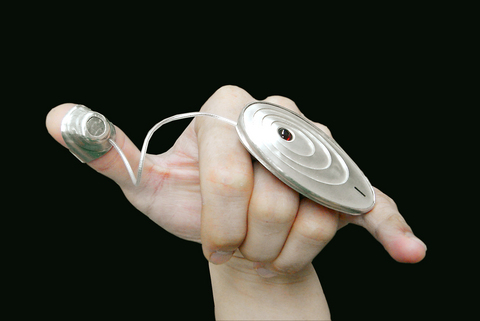

May 26 to June 1 When the Qing Dynasty first took control over many parts of Taiwan in 1684, it roughly continued the Kingdom of Tungning’s administrative borders (see below), setting up one prefecture and three counties. The actual area of control covered today’s Chiayi, Tainan and Kaohsiung. The administrative center was in Taiwan Prefecture, in today’s Tainan. But as Han settlement expanded and due to rebellions and other international incidents, the administrative units became more complex. By the time Taiwan became a province of the Qing in 1887, there were three prefectures, eleven counties, three subprefectures and one directly-administered prefecture, with

Taiwan Power Co (Taipower, 台電) and the New Taipei City Government in May last year agreed to allow the activation of a spent fuel storage facility for the Jinshan Nuclear Power Plant in Shihmen District (石門). The deal ended eleven years of legal wrangling. According to the Taipower announcement, the city government engaged in repeated delays, failing to approve water and soil conservation plans. Taipower said at the time that plans for another dry storage facility for the Guosheng Nuclear Power Plant in New Taipei City’s Wanli District (萬里) remained stuck in legal limbo. Later that year an agreement was reached

What does the Taiwan People’s Party (TPP) in the Huang Kuo-chang (黃國昌) era stand for? What sets it apart from their allies, the Chinese Nationalist Party (KMT)? With some shifts in tone and emphasis, the KMT’s stances have not changed significantly since the late 2000s and the era of former president Ma Ying-jeou (馬英九). The Democratic Progressive Party’s (DPP) current platform formed in the mid-2010s under the guidance of Tsai Ing-wen (蔡英文), and current President William Lai (賴清德) campaigned on continuity. Though their ideological stances may be a bit stale, they have the advantage of being broadly understood by the voters.

In a high-rise office building in Taipei’s government district, the primary agency for maintaining links to Thailand’s 108 Yunnan villages — which are home to a population of around 200,000 descendants of the Chinese Nationalist Party (KMT) armies stranded in Thailand following the Chinese Civil War — is the Overseas Community Affairs Council (OCAC). Established in China in 1926, the OCAC was born of a mandate to support Chinese education, culture and economic development in far flung Chinese diaspora communities, which, especially in southeast Asia, had underwritten the military insurgencies against the Qing Dynasty that led to the founding of